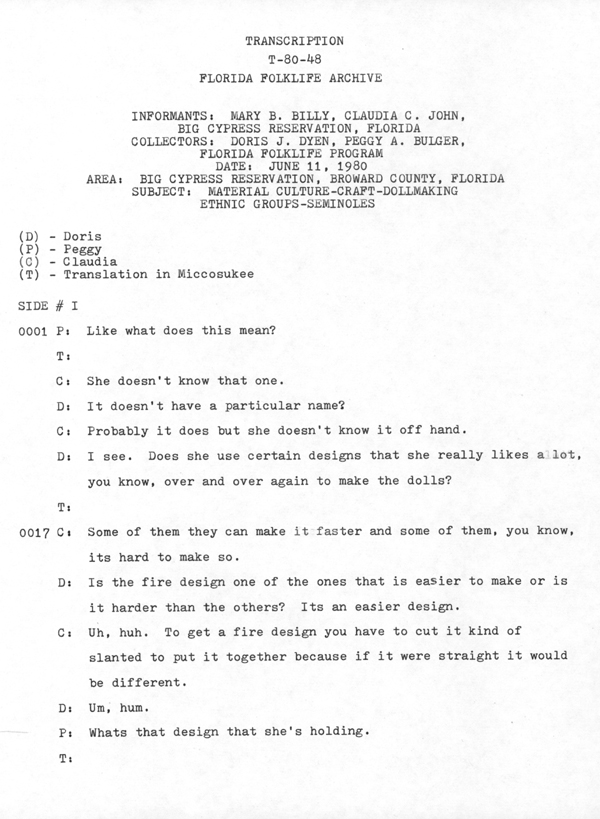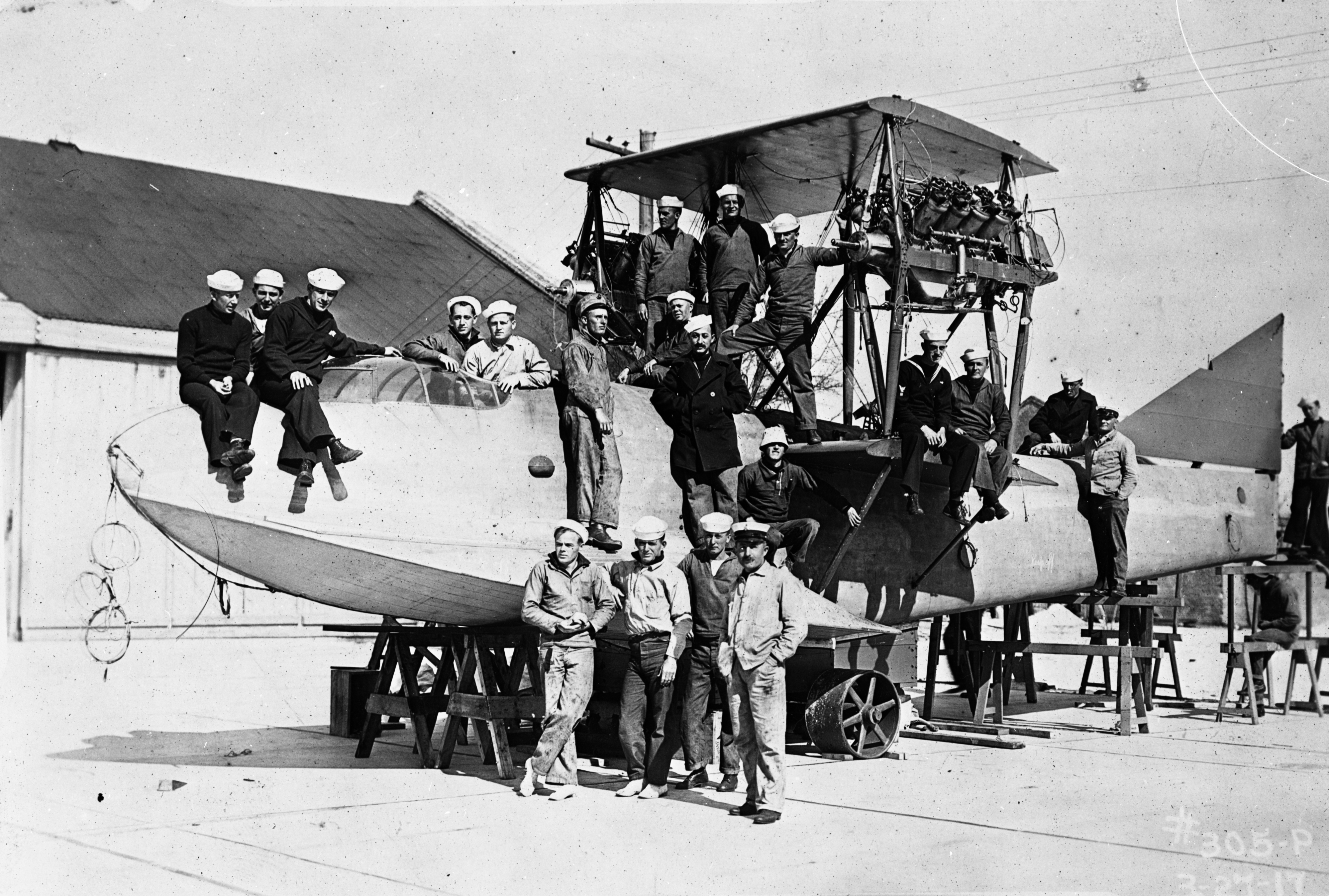Seminole Doll Making
Documents and Audio
Interview with Mary B. Billie, Seminole Doll Maker
From: Audio recordings of Florida Folk Festival performances and other folk events, 1935-2001, Series S 1576

TRANSCRIPTION
T-80-48
FLORIDA FOLKLIFE ARCHIVE
INFORMANTS: MARY B. BILLY, CLAUDIA C. JOHN, BIG CYPRESS RESERVATION, FLORIDA
COLLECTORS: DORIS J. DYEN, PEGGY A. BULGER,
FLORIDA FOLKLIFE PROGRAM
DATE: JUNE 11, 1980
AREA: BIG CYPRESS RESERVATION, BROWARD COUNTY, FLORIDA
SUBJECT: MATERIAL CULTURE-CRAFT-DOLLMAKING, ETHNIC GROUPS-SEMINOLES
(D) - Doris
(P) - Peggy
(C) - Claudia
(T) - Translation in Miccosukee
SIDE # I
0001
P: Like what does this mean?
T:
C: She doesn't know that one.
D: It doesn't have a particular name?
C: Probably it does but she doesn't know it off hand.
D: I see. Does she use certain designs that she really likes a lot, do you know, over and over again to make the dolls?
T:
0017
C: Some of them they can make it faster and some of them, you know, it's hard to make so.
D: Is the fire design one of the ones that is easier to make or is it harder than the others? It's an easier design.
C: Uh, huh. To get a fire design you have to cut it kind of slanted to put it together because if it were straight it would be different.
D: Um, hum.
P: What's that design that she's holding?
T:
P: Or does it have it. Have the Seminole people always had the patchwork or is that a new thing?
0040
C: Uh, they always had it for a long time but it's just they're doing it different ways now than they used to do it back then. It's kind of different than today's.
T:
C: They used to war that cowhide.
P: Cowhide. Um, hum.
C: Oh, it's not cowhide. She said it was...
T:
C: Oh, deerhide she said.
D: Deerhide, but a kind of leather.
0054
C: Uh, huh. But there ( ) it's strange now that the white people brought and they started buying it or trading something else for the material. That's how they start getting that.
P: This would be cooler, wouldn't it? Cause the leather would be so hot.
C: Moccasins.
P: Oh, right.
D: To make, you mean to wear on the feet.
T:
C: Moccasins is a kind of shoes.
P: I have seen pictures where they are wearing like a leather vest and pants. It would be awfully hot, I would think, down here.
D: How many different designs does she usually use to make the dolls? Is it just two or three or does she switch off?
C: Different types?
D: Yeh, right. Different types of design.
T:
C: Maybe about six different types of design.
D: Six different patchwork designs. And about the dolls' hairdos, we were seeing that some of them are made with that cardboard like a semicircle and they sort of stick out. And then others ones are made with yarn. Which ones look more like the way most Seminole women wear today?
T:
0102
C: The one that has the pony tails and the braided ones.
D: so the ones made with yarn with the pony tail.
C: That's today's.
D: And the one that's made with the fabric and the semicircle, that was from...
C: Way back. About eight years before.
T:
C: About six years before.
D: Yeh. You never wear your hair like that?
C: Oh, yeh.
P: It'd be hard to do, to try to, yeh.
T:
0117
C: My grandmother used to do that. She used to wear a lot of beads. That's what they used to do. They would be heavy.
P: Uh, huh.
D: So really, the dolls look like Seminole women used to look.
C: Um, hum. Some of them.
D: But not necessarily like the Seminole women look today. Are there any...
C: There's a few left that wars that cardboard thing on their head.
D: There are still a few women that do.
C: Uh, huh.
D: Are there... I've lost my train of thought. Happens to me too. Oh, one other thing. Your mother made the dolls because she earns her living that way.
C: Uh, huh.
D: So it's kind of an economic thing as well as symbolic.
T:
0149
C: She said, uh, she does it, I guess she enjoys it a little bit, but she says she doesn't enjoy it that much, that well. The reason she does it is it's the only income she gets. She doesn't work, you know. That's just what she does all her life.
D: Right. For one of the small dolls, how much money does she earn when she makes one of the small dolls? Is there a certain percentage, you know, the way the tribe does it or the way the arts and crafts center?
T:
C: She said they used to sell it for twenty five cents.
D: Really?
0173
C: Like with, Judy Bills ( ) to fill any order in her ( ) she pays her like $1.25 a doll. But she just orders it at different times.
D: I see. And the rest...
C: It depends on how many they ask for to ship out or something.
D: And then the rest of the money goes to the tribe.
C: I guess it does.
D: Are all the dolls figures of women? Does anyone ever make dolls that are men?
0184
C: Yes, she makes some mens dolls too. She's got one right there.
D: Are they made to look just like the medicine man or just a Seminole man just any person?
T:
C: Medicine man.
D: I see.
C; She's got some that's just a, not a medicine man.
D: Just a man figure.
P: Speaking of men, you said your brother learned how to make the dolls. Is that pretty usual or do boys pretty much stay away, but men...
0199
C: Some men know how to make the dolls. But usually men do the gardening.
P: And the women pretty much do the crafts. The patchwork.
C: Um, hum.
P: Do different colors mean different things? Like red. Does red mean something?
T:
C: She say maybe they do but she said she really doesn't know.
P: It's probably been lost if it meant...
C: Yeh.
P: Right.
D: Does she make other kinds of, does she do other kinds of crafts as well, such as baskets or something like that?
T:
0232
C: She said she used to make some ones and they order that basket. But she had to look for the sweetgrass, too.
D: So the baskets are sweetgrass baskets that she made. Does anyone else around also make baskets just here in this area, in
Big Cypress?
0242
C: Yeh. There are some other people that makes it. Like there are some people in the mountains, quite a few ladies, that makes it. Maybe in Brighton, here and Hollywood too.
D: You mentioned one lady, Louise...
C: Doctor.
D: Louise Doctor. And she lives right here with you.
C: Yes.
(Truck goes by)
D: Well, I think that's it.
P: That's good. You did it.
0255
END OF TAPE
SIDE II - BLANK

 Listen: The Assorted Selections Program
Listen: The Assorted Selections Program